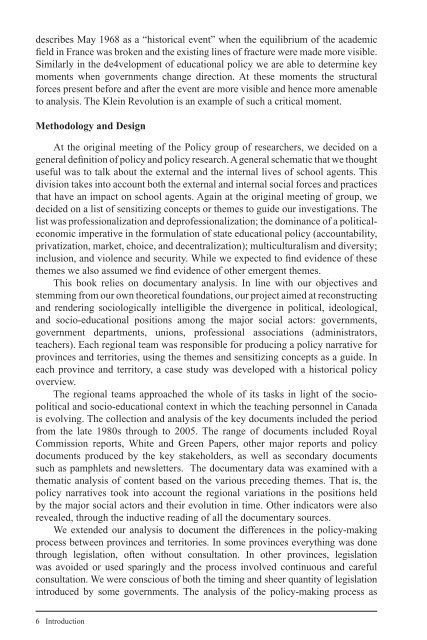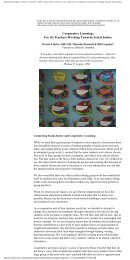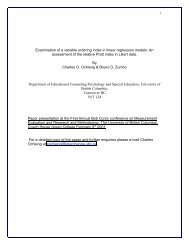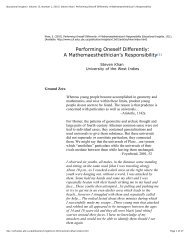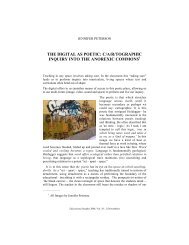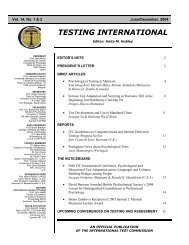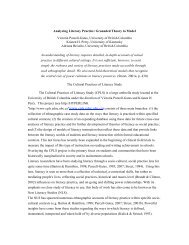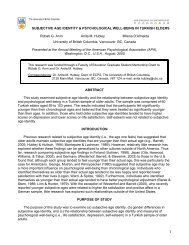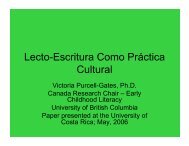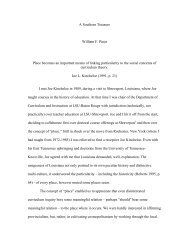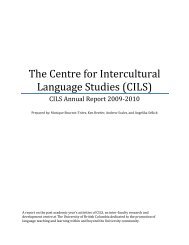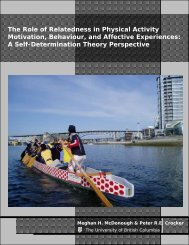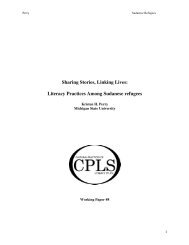The evolution of professionalism - Centre for Policy Studies in ...
The evolution of professionalism - Centre for Policy Studies in ...
The evolution of professionalism - Centre for Policy Studies in ...
You also want an ePaper? Increase the reach of your titles
YUMPU automatically turns print PDFs into web optimized ePapers that Google loves.
describes May 1968 as a “historical event” when the equilibrium <strong>of</strong> the academic<br />
fi eld <strong>in</strong> France was broken and the exist<strong>in</strong>g l<strong>in</strong>es <strong>of</strong> fracture were made more visible.<br />
Similarly <strong>in</strong> the de4velopment <strong>of</strong> educational policy we are able to determ<strong>in</strong>e key<br />
moments when governments change direction. At these moments the structural<br />
<strong>for</strong>ces present be<strong>for</strong>e and after the event are more visible and hence more amenable<br />
to analysis. <strong>The</strong> Kle<strong>in</strong> R<strong>evolution</strong> is an example <strong>of</strong> such a critical moment.<br />
Methodology and Design<br />
At the orig<strong>in</strong>al meet<strong>in</strong>g <strong>of</strong> the <strong>Policy</strong> group <strong>of</strong> researchers, we decided on a<br />
general defi nition <strong>of</strong> policy and policy research. A general schematic that we thought<br />
useful was to talk about the external and the <strong>in</strong>ternal lives <strong>of</strong> school agents. This<br />
division takes <strong>in</strong>to account both the external and <strong>in</strong>ternal social <strong>for</strong>ces and practices<br />
that have an impact on school agents. Aga<strong>in</strong> at the orig<strong>in</strong>al meet<strong>in</strong>g <strong>of</strong> group, we<br />
decided on a list <strong>of</strong> sensitiz<strong>in</strong>g concepts or themes to guide our <strong>in</strong>vestigations. <strong>The</strong><br />
list was pr<strong>of</strong>essionalization and depr<strong>of</strong>essionalization; the dom<strong>in</strong>ance <strong>of</strong> a politicaleconomic<br />
imperative <strong>in</strong> the <strong>for</strong>mulation <strong>of</strong> state educational policy (accountability,<br />
privatization, market, choice, and decentralization); multiculturalism and diversity;<br />
<strong>in</strong>clusion, and violence and security. While we expected to fi nd evidence <strong>of</strong> these<br />
themes we also assumed we fi nd evidence <strong>of</strong> other emergent themes.<br />
This book relies on documentary analysis. In l<strong>in</strong>e with our objectives and<br />
stemm<strong>in</strong>g from our own theoretical foundations, our project aimed at reconstruct<strong>in</strong>g<br />
and render<strong>in</strong>g sociologically <strong>in</strong>telligible the divergence <strong>in</strong> political, ideological,<br />
and socio-educational positions among the major social actors: governments,<br />
government departments, unions, pr<strong>of</strong>essional associations (adm<strong>in</strong>istrators,<br />
teachers). Each regional team was responsible <strong>for</strong> produc<strong>in</strong>g a policy narrative <strong>for</strong><br />
prov<strong>in</strong>ces and territories, us<strong>in</strong>g the themes and sensitiz<strong>in</strong>g concepts as a guide. In<br />
each prov<strong>in</strong>ce and territory, a case study was developed with a historical policy<br />
overview.<br />
<strong>The</strong> regional teams approached the whole <strong>of</strong> its tasks <strong>in</strong> light <strong>of</strong> the sociopolitical<br />
and socio-educational context <strong>in</strong> which the teach<strong>in</strong>g personnel <strong>in</strong> Canada<br />
is evolv<strong>in</strong>g. <strong>The</strong> collection and analysis <strong>of</strong> the key documents <strong>in</strong>cluded the period<br />
from the late 1980s through to 2005. <strong>The</strong> range <strong>of</strong> documents <strong>in</strong>cluded Royal<br />
Commission reports, White and Green Papers, other major reports and policy<br />
documents produced by the key stakeholders, as well as secondary documents<br />
such as pamphlets and newsletters. <strong>The</strong> documentary data was exam<strong>in</strong>ed with a<br />
thematic analysis <strong>of</strong> content based on the various preced<strong>in</strong>g themes. That is, the<br />
policy narratives took <strong>in</strong>to account the regional variations <strong>in</strong> the positions held<br />
by the major social actors and their <strong>evolution</strong> <strong>in</strong> time. Other <strong>in</strong>dicators were also<br />
revealed, through the <strong>in</strong>ductive read<strong>in</strong>g <strong>of</strong> all the documentary sources.<br />
We extended our analysis to document the differences <strong>in</strong> the policy-mak<strong>in</strong>g<br />
process between prov<strong>in</strong>ces and territories. In some prov<strong>in</strong>ces everyth<strong>in</strong>g was done<br />
through legislation, <strong>of</strong>ten without consultation. In other prov<strong>in</strong>ces, legislation<br />
was avoided or used spar<strong>in</strong>gly and the process <strong>in</strong>volved cont<strong>in</strong>uous and careful<br />
consultation. We were conscious <strong>of</strong> both the tim<strong>in</strong>g and sheer quantity <strong>of</strong> legislation<br />
<strong>in</strong>troduced by some governments. <strong>The</strong> analysis <strong>of</strong> the policy-mak<strong>in</strong>g process as<br />
6 Introduction


